Explore the Hidden World of Baboons in Africa: Intelligent, social, and full of surprises, baboons are a fascinating aspect of Africa’s rich wildlife.
Discover their complex societies, survival skills, and the unique place they hold in nature and culture. Dive into this captivating article to uncover the secrets of these remarkable creatures!
Baboons in Africa: General Facts
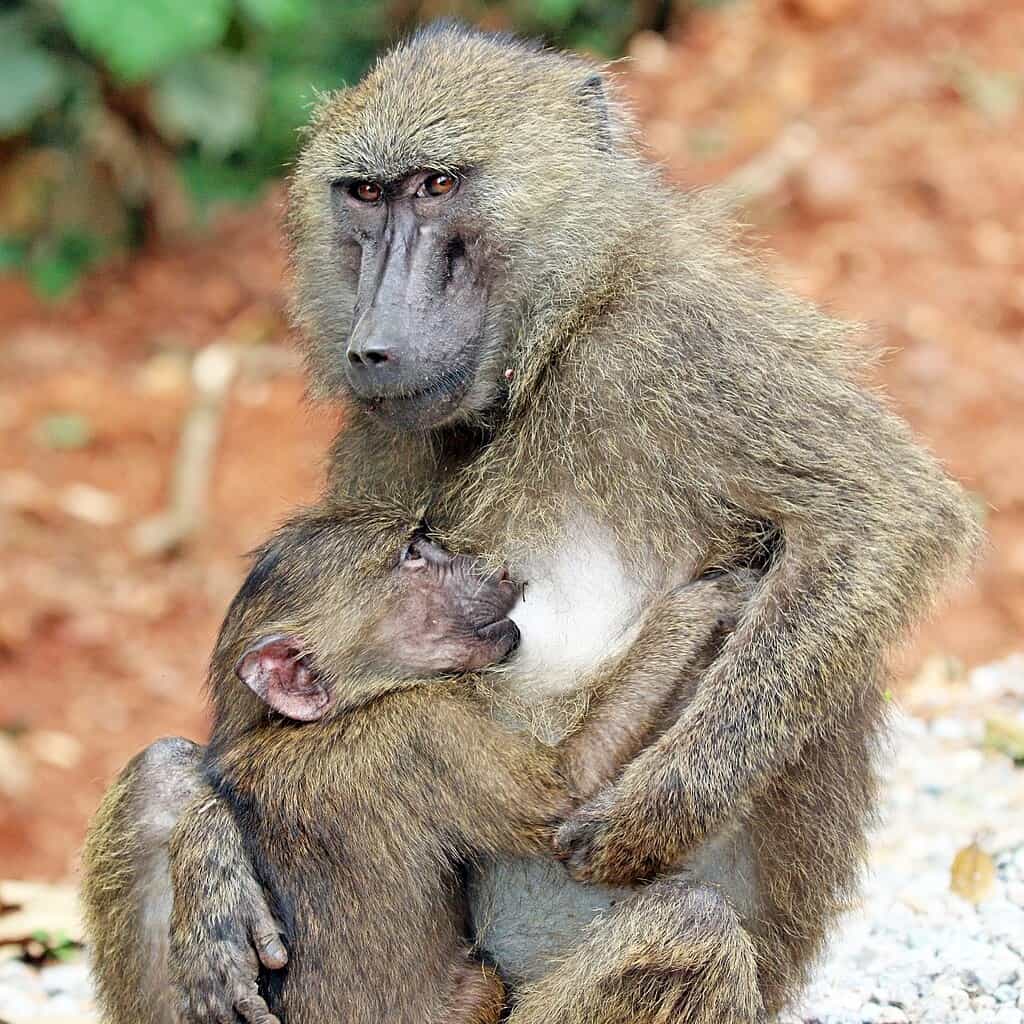
Five species of baboons exist around the world. These Baboon species are the Chacma, Olive, Yellow, Guinea, and Hamadryas baboons.
Four of which ( excluding the Hamadryas) can be found in southern, central and northern Africa. They are known as Savanna baboons. These baboons are categorized too, by their complex, hierarchical order of troops which may consist of up to hundreds of members. A fascination to study and track. Troops are known to be dominated by males who influence movements and relationships that exist within the group structure. The Hamadryas baboon, an exception, may be located along the red sea, Northern Africa and Arabia. Cliff dwellers by night and foragers by day. They differ in more intimate troop sizes. Baboons are very compassionate toward their own members within a troop, doing anything to protect and care for them. This can be mistaken for aggression but shouldn’t be.
Don’t be mistaken by the description of Old World Monkeys which is a genus ( subfamily) of primates including the species of baboon.
| Order: Primates |
| Weight: 9-31 kg |
| Diet: Omnivorous |
| Lifespan: 15- 40 years |
| Predators: Humans and big cats, birds of prey, crocodiles |
| Habitat: Savannah and woodlands |
| Gestation period: approximately 6 months. Mature upon ages of 6-8 (African Wildlife Foundation) |
| Distinct Regions: Semi-arid and savannah Africa and Arabia |
| Troops: Male-dominated leadership and females ranked by birth order. |
| Baboons‘ sexual maturity: between the ages of 5 and 8. |
| Unlike Monkeys: Baboons do not have prehensile tails to use as an extra limb (when climbing trees) |
| Lifespan: 30 years in the wild and up to 45 years in captivity. |
| Daytime: They travel long distances in the morning and afternoon in search of food |
| Night time: Seek camouflage in tree tops/ sheltered shrubs/ rocky areas |
Different baboon species
Have a look at the different species of baboons.
| Baboon Species | Olive papio anubis | Yellow Papio cynocephalus | Guinea Papio papio | Hamadryas Papio hamadryas | ChacmaPapio ursinus |
| Coat | Green-Grey | Light-Brownish yellow coat | Reddish Coat/ Small frame | White/Silver (male) and Brown (female)coat | Large, Heavy, Dark Brown |
| Location | Equatorial Africa | Central Africa | West Africa | Northeastern Africa along the Red Sea | Southern Africa |
| Habitat | Savannah, woodlands, Grasslands | Savannah, forests & shrubs | Savannah, woodlands & coastal grasslands | Savannah semi-desert and rocky areas | Savannah and semi-arid desert |
| Avg. Life span | 25 years | 15-20 Years | 20- 30 years | 20 years | 30-40 years |
| Group Dynamic | 15- 200 members in a troop | 20- 200 members in a troop | Up to 200 members | Four- Level social system forming a troop | Smaller social groupings: male, females and offspring |
You can learn more about where to see baboons in the next chapter.
Where to encounter Baboons in Africa
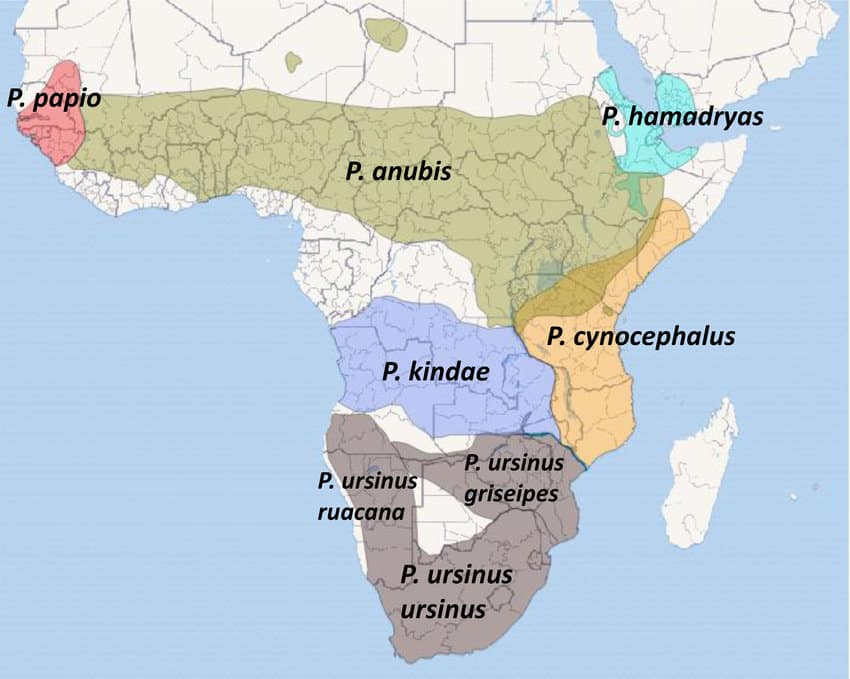
We have found some of the best places to observe Baboons in Africa, in their natural Habitats.
#1 Olive Baboons in Kenya
The common name is derived from its coat colour, which is a shade of green-grey at a distance.
Olive baboons also practice a variety of communications, vocal and non-vocal, facilitating a complex social structure. Geographical range: Found throughout and across 25 Equatorial Africa. The highest population can be found in New Guinea.
Visit:
- Safari in Kenya
- Tour Operator: Shadows of Africa Tours
#2 Yellow Baboons:
The scientific name of yellow baboons is derived from Greek, meaning ‘dog-head,’ a nod to their canine-like facial structure. These baboons are noted for their relatively smaller size, with slender bodies, elongated limbs, and a coat of yellowish-brown fur. They bear a resemblance to the smaller Chacma baboon but with a shorter muzzle, and their distinctive color sets them apart.
Inhabiting the savannas and light woodlands of eastern Africa, their range spans from Kenya and Tanzania to Zimbabwe and Botswana. Yellow baboons are ground-dwelling during daylight hours and live in large, diverse social groups ranging from eight to 200 members. Their omnivorous diet primarily includes fruits, supplemented by plants, seeds, bark, flowers, and small animals like worms or insects, and even rodents.
Communication within their groups and with others is facilitated through at least 10 distinct vocal sounds. The troop’s movement is organized with males, females, and young in the center, surrounded by less dominant males at the rear. This hierarchy plays a crucial role in the troop’s order, mobility, defense, and survival in the harsh wilderness. Yellow baboons can have a lifespan of up to 20 years.
Visit:
- Zambian Border Victoria Falls and Kasanka National park
- Tour operators: Absolute Zambia safaris
#3 Guinea Baboons:
The Guinea baboon is native to a limited region in West Africa, occupying territories across Guinea, Senegal, Gambia, southern Mauritania, and western Mali.
These baboons are easily recognizable by their unique reddish-brown fur and a hairless face that ranges in color from dark violet to black, featuring a characteristic canine-like snout edged by a slender mane. They are diurnal, spending their days active, and retreat to the safety of trees or elevated rock structures for nighttime rest, away from predators. The availability of appropriate trees for sleeping often determines both the size of their groups and the extent of their habitat range.
Visit:
- Western Africa, Gambia: Abuko Nature reserve
- Tour Operators: Black and white Safari tours
#4 Hamadryas Baboons:
Hamadryas Baboons have been wandering the northeastern African desert for thousands of years. Even worshipped in Ancient Egyptian Mythology.
The baboon’s geographical range extends from the Red Sea in Eritrea to Ethiopia, Djibouti and Somalia. They have also been uncommonly known to move as far as the Sarawak region of southwestern Arabia, in both Yemen and Saudi Arabia.
Hamadryas baboons have a fascinating four-level social system called a multilevel society, where much of the social interaction occurs within small groups called one-male units (harems) containing one male and up to 10 females. A Harem often includes a younger follower or followers( male) that may be related to the leader.
However when two/ more harems join they form clans, where males are close relatives of one another in an age-related hierarchy. Bands are the next level. Two to four clans form bands of up to 400 individuals which usually travel and sleep as a group.
Visit:
- North East Africa/ Red Sea
- Tour Operators: Safari Sahara, Egypt
#5 Chacma Baboons:
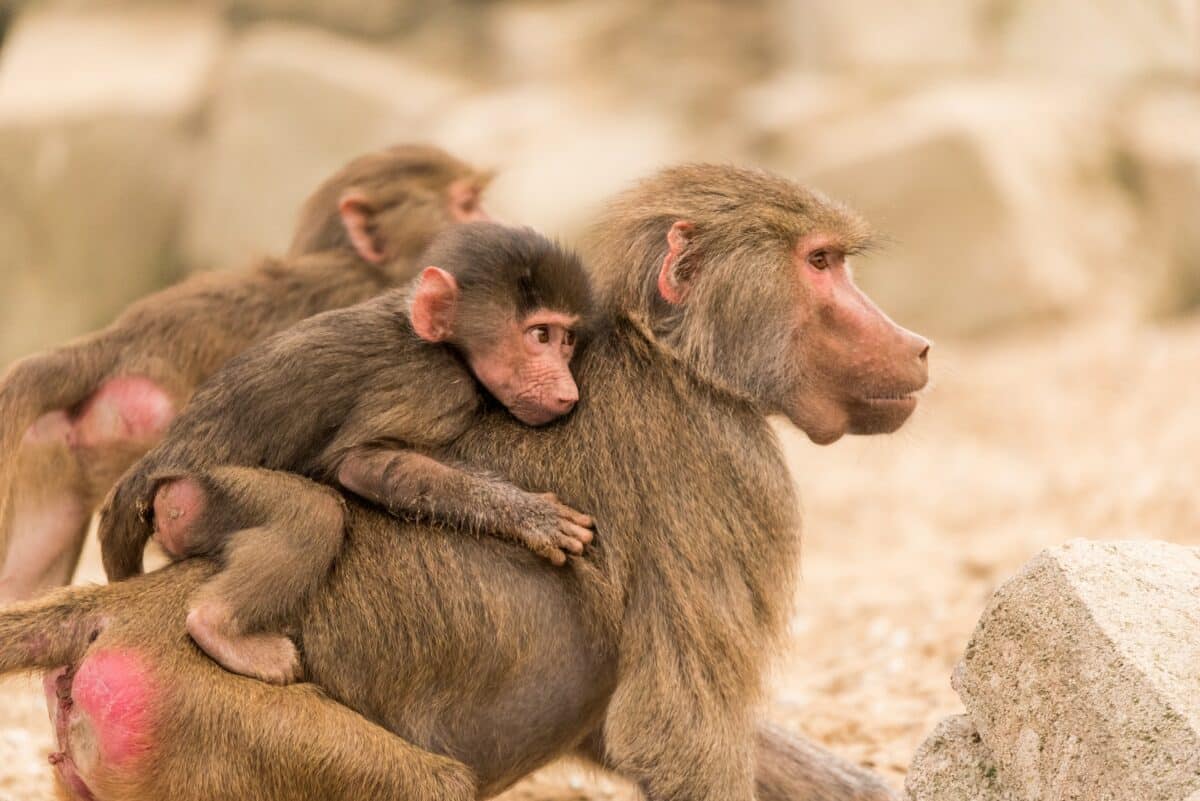
South Africa boasts some of the most visited tourist spots in the world, featuring endemic biodiversity and wildlife that varies extensively, offering a vibrant experience for visitors.
The chacma baboons are an unmissable feature of Cape Town’s tourism attractions, in troops located along the stretch of the mountain that makes up the Table Mountain National Park. Currently, 11 troops of baboons exist in the Cape.
These troops range from 20- 200 members who have assimilated into settlements footing mountain access, interacting with human communities and adapting their lifestyle to integrate into the development of urban structures which encroach on their natural habitat.
The word “chacma” is derived from the Hottentot (Khoikhoi) name for a baboon. Remarkably the Chacma baboons in the cape and along the coastal stretches of the mountain side, have sustained a diet of fruit, roots, insects and foraging mussels along the shore-front; a lifestyle and diet reminiscent of human ancestors in the cape 100 000 years ago.
Visit:
- Local wonders: Smitswinkel Bay Beach
- Cape Point stays: Olifantsbos Guest House and Eland and Duikers Cottage
- Tour Operators: City Sightseeing South Africa.
- Table Mountain reserve: A coastal route from Simon’s town, Cape town, around the southern Peninsula, Scarborough, Kommetjie, through Noordhoek, and over Chapman’s peak to Hout Bay for an unfiltered and organic experience of witnessing baboon troops merging with the human community along the route.
Also Visit:
- Mpumalanga Province: Kruger National park
- Kruger park Tours by African Safari Vacations
Are Baboons Dangerous?

We need to fall in love with Baboons again. They have often been misunderstood, vilified, and associated with fear. Still, they are brilliant animals that intrigue and delight those lucky enough to see them in their natural habitat.
However, in this environment, baboons must be given personal space regarding conservation and protection regulations. No touching or feeding of baboons is permitted, and a safe distance between people and baboons must be practiced at all times. Despite their impressively threatening teeth, they are not natural hunters, with their teeth as a protective measure if provoked.
They commonly maintain non-aggressive behavior unless vulnerable, threatened, or provoked, under which circumstances baboons would be trying to protect their troop, especially the young. Therefore it is essential to be aware of boundaries when encountering these wild animals.
This can be practiced by acknowledging and respecting baboon body language. Fear can be interpreted in acts such as running with a straight and upwards tail, high pitch screaming, and expressions of grimace where lips are pulled back to reveal teeth. Therefore being aware of this and respecting a baboon’s space will allow for a peaceful relationship between humans and baboons.
There have been some remarkable baboons. One is Jack, the railroad worker in South Africa in the 1800s. Jack, a young Cape Chacma Baboon, spotted pushing an Oxwagon, was homed by a disabled train signaler, Jumper. Jack would move Jumper on a trolley to the railroad track, where he would signal lanes for oncoming trains to use.
People traveled from afar, hoping to see Jack the baboon working on the tracks and astonishing all who witnessed his intelligence and capability to work alongside human beings—one of many incredible baboons.
Can we fall in love with these beautiful creatures who feel and observe the world around them so passionately?
Baboons in Africa: Conservation status and efforts to protect them
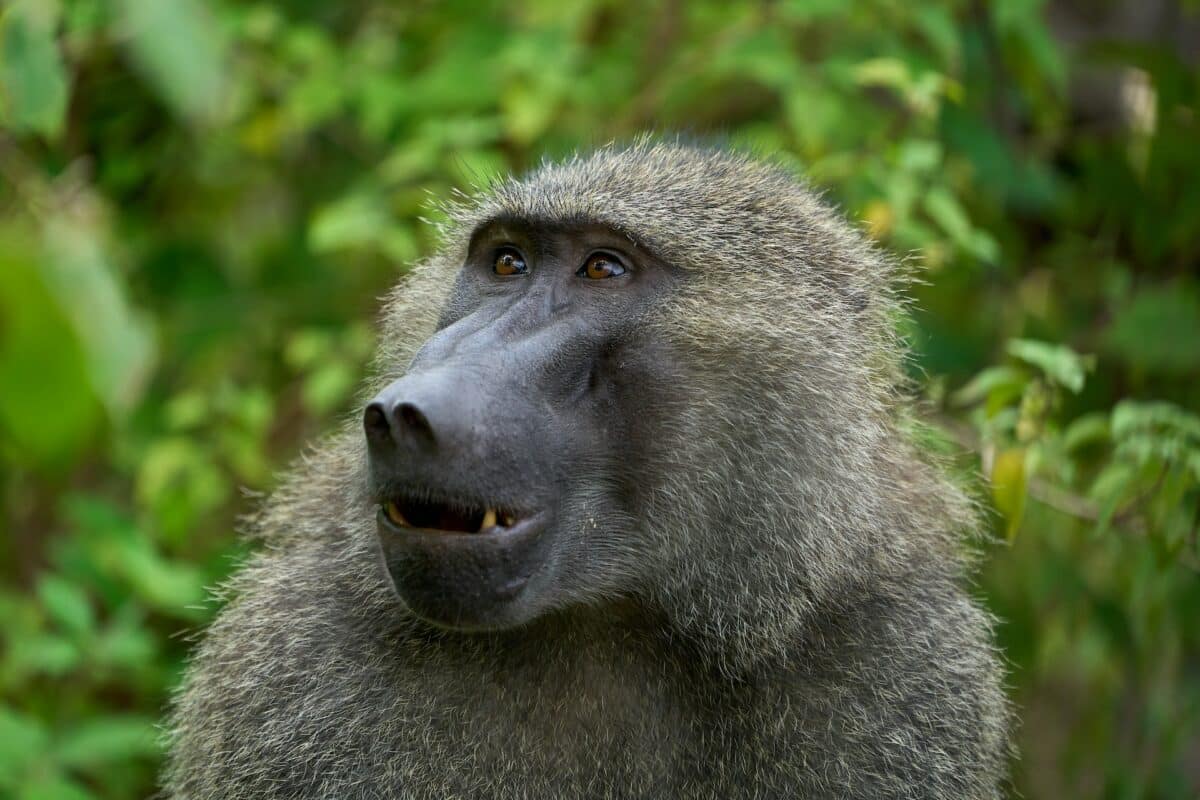
An animal’s conservation status is measured under stages monitored accordingly as; Least Concern- near threatened – threatened ( non-critical and critical)- extinct.
| Olive Baboon: Least Concern African Wildlife Foundation |
| Yellow Baboon: Least Concern New England primate Conservancy |
| Guinea Baboon: Near threatened African Wildlife Foundation |
| Hamadryas: Least Concern Filoha Hamadryas Project |
| Chacma baboon: Least Concern Baboon Matters Advocacy |
You can visit the following conservation websites to donate or learn how to protect Baboons in Africa and raise further awareness.
The Guinea baboon is currently the only species with threatened conservation status. The remaining four baboon species are not officially listed as endangered, despite the reduction in troop numbers over the last decade. However, they are monitored by rangers to manage the threat posed by humans on baboons’ habitats in reserves open to high annual tourism rates. Baboons that disrupt human settlements are often euthanized instead of relocated or rehabilitated.
This has been evident in decades of human-wildlife conflict and the overriding conflict over wildlife. Through which unstable baboon management guidelines were established. However, these guidelines have not always been upheld. Due to the impact of sprawling development affecting areas of baboons, they have become opportunists concerning food, drawn to houses, restaurants, shops, etc. This is an effect of tourists feeding baboons despite warnings against this practice. Therefore baboons associate human activity and settlements with the opportunity to get food.
Tour operators have been found guilty of luring baboons with food to impress tourists. This has led to an unnatural co-dependence and conflict between protection efforts, profit, and changes in animal behavior and their habitats to be closer to human settlements and roadways, ultimately threatening their existence.
Therefore, tour operators and tourists are responsible for not feeding baboons or encouraging codependency. This will sustain a positive relationship between Baboons in Africa and those lucky to encounter them.
Summary of Baboons in Africa
Five species of Baboons in Africa exist. They are sensitive and brilliant social creatures. Witnessing their social dynamics and caring for one another is a remarkable sight. We hope you’ll be able to visit them in their natural habitats, where they roam their world, which borders on our own. They are not animals to fear but to love, and we should honor their existence by promoting their beautiful natures.
Fall in love with baboons after reading “My Friends, The Baboons” by South African Naturalist Eugene Marais.
Want to learn more about the Baboon primates family? Have a look at our article about Where to See Chimpanzees or Watch a Chimpanzee throw a Water Bottle at Zoo Visitor.
Join our Forum for free today!

- These are The 5 Largest Great White Sharks Ever Recorded - July 19, 2024
- The Surprising Benefits of Big Game Hunting - July 18, 2024
- $100k+ Hunting Experiences The Most Expensive Animals to Pursue - July 17, 2024

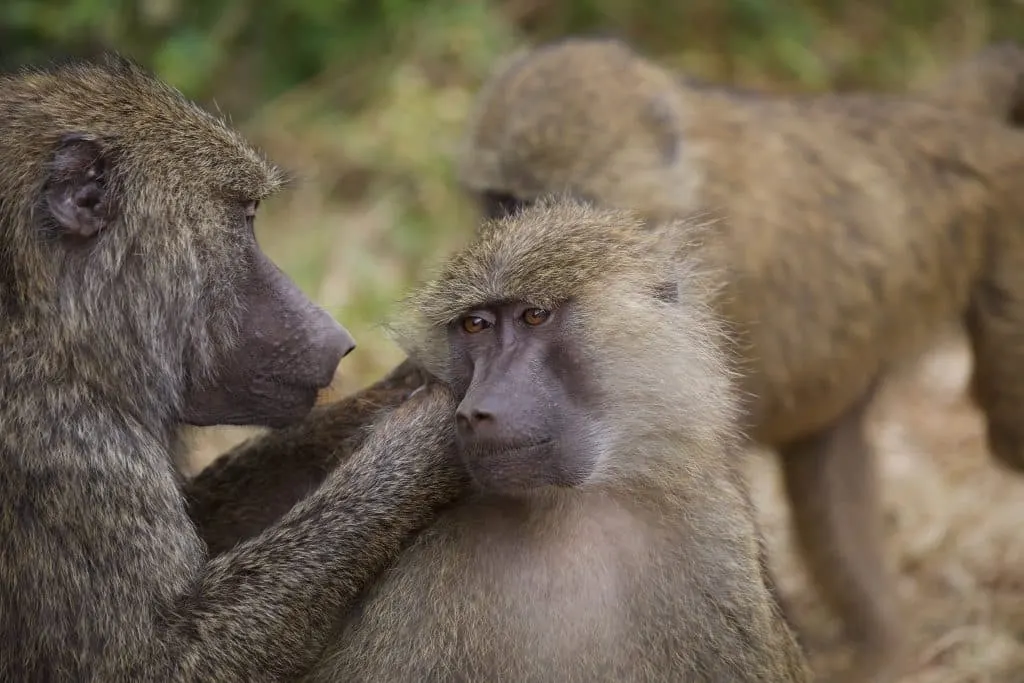



Jen
Friday 12th of June 2020
Learnt so much! More people should be more aware of our local animals
Taryn-Lee
Thursday 11th of June 2020
So interesting!